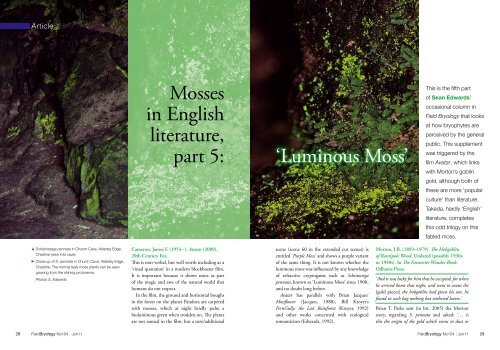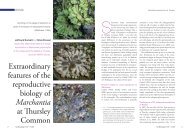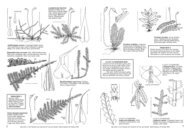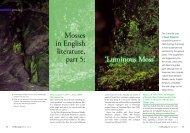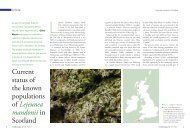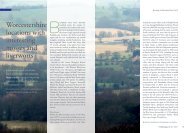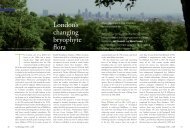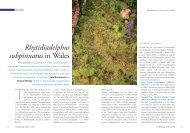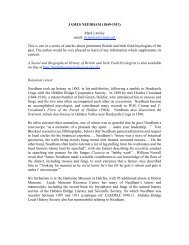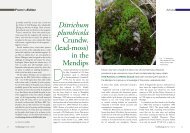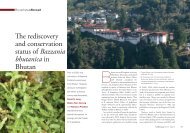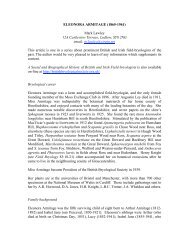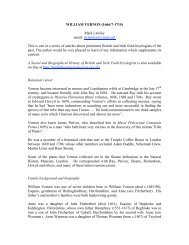Mosses in English literature, part 5: 'Luminous Moss'
Mosses in English literature, part 5: 'Luminous Moss'
Mosses in English literature, part 5: 'Luminous Moss'
Create successful ePaper yourself
Turn your PDF publications into a flip-book with our unique Google optimized e-Paper software.
Article<br />
m Schistostega pennata <strong>in</strong> Church Cave, Alderley Edge,<br />
Cheshire (view <strong>in</strong>to cave).<br />
c Close-up of S. pennata <strong>in</strong> Church Cave, Alderley Edge,<br />
Cheshire. The normal leafy moss plants can be seen<br />
grow<strong>in</strong>g from the sh<strong>in</strong><strong>in</strong>g protonema.<br />
Photos S. Edwards<br />
<strong>Mosses</strong><br />
<strong>in</strong> <strong>English</strong><br />
<strong>literature</strong>,<br />
<strong>part</strong> 5: ‘Lum<strong>in</strong>ous Moss’<br />
Cameron, James F. (1954–). Avatar (2009),<br />
20th Century Fox.<br />
This is non-verbal, but well worth <strong>in</strong>clud<strong>in</strong>g as a<br />
‘visual quotation’ <strong>in</strong> a modern blockbuster film.<br />
It is important because it shows moss as <strong>part</strong><br />
of the magic and awe of the natural world that<br />
humans do not respect.<br />
In the film, the ground and horizontal boughs<br />
<strong>in</strong> the forest on the planet Pandora are carpeted<br />
with mosses, which at night briefly pulse a<br />
biolum<strong>in</strong>ous green when trodden on. The plants<br />
are not named <strong>in</strong> the film, but a new/additional<br />
scene (scene 60 <strong>in</strong> the extended cut scenes) is<br />
entitled ‘Purple Moss’ and shows a purple variant<br />
of the same th<strong>in</strong>g. It is not known whether the<br />
lum<strong>in</strong>ous moss was <strong>in</strong>fluenced by any knowledge<br />
of refractive cryptogams such as Schistostega<br />
pennata, known as ‘Lum<strong>in</strong>ous Moss’ s<strong>in</strong>ce 1900,<br />
and no doubt long before.<br />
Avatar has parallels with Brian Jacques’<br />
Mossflower (Jacques, 1988), Bill Kroyer’s<br />
FernGully: the Last Ra<strong>in</strong>forest (Kroyer, 1992)<br />
and other works concerned with ecological<br />
romanticism (Edwards, 1992).<br />
This is the fifth <strong>part</strong><br />
of Sean Edwards’<br />
occasional column <strong>in</strong><br />
Field Bryology that looks<br />
at how bryophytes are<br />
perceived by the general<br />
public. This supplement<br />
was triggered by the<br />
film Avatar, which l<strong>in</strong>ks<br />
with Morton’s gobl<strong>in</strong><br />
gold, although both of<br />
these are more ‘popular<br />
culture’ than <strong>literature</strong>.<br />
Takeda, hardly ‘<strong>English</strong>’<br />
<strong>literature</strong>, completes<br />
this odd trilogy on this<br />
fabled moss.<br />
Morton, J.B. (1893–1979). The Hobgobl<strong>in</strong><br />
of Rantipole Wood. Undated (possibly 1930s<br />
or 1940s). In The Favourite Wonder Book,<br />
Odhams Press.<br />
‘And it was lucky for him that he accepted, for when<br />
he arrived home that night, and went to count the<br />
[gold pieces] the hobgobl<strong>in</strong> had given his son, he<br />
found <strong>in</strong> each bag noth<strong>in</strong>g but withered leaves.’<br />
Brian T. Parks sent (<strong>in</strong> litt. 2005) the Morton<br />
story, regard<strong>in</strong>g S. pennata and asked: ‘… is<br />
this the orig<strong>in</strong> of the gold which turns to dust or<br />
28 FieldBryology No104 | Jun11 FieldBryology No104 | Jun11 29
<strong>Mosses</strong> <strong>in</strong> <strong>English</strong> <strong>literature</strong>, <strong>part</strong> 5 <strong>Mosses</strong> <strong>in</strong> <strong>English</strong> <strong>literature</strong>, <strong>part</strong> 5<br />
dry leaves found so often <strong>in</strong> European fairy tales? ’<br />
There are endless references on the web to fairy<br />
gold that turns to dust or dry leaves <strong>in</strong> daylight,<br />
but no early published source material of such<br />
a fairy tale has been found. The first found<br />
association (Edwards, 1997) of ‘Gobl<strong>in</strong> Gold’<br />
with Schistostega was <strong>in</strong> 1903 by Grout. He calls<br />
it ‘Lum<strong>in</strong>ous Moss’ and observes ‘This beautiful<br />
plant is probably the reality upon which are based<br />
the fairy tales of gobl<strong>in</strong> gold.’<br />
The cave-dwell<strong>in</strong>g, sh<strong>in</strong><strong>in</strong>g, emerald green cells<br />
were described as an alga (Catoptridium smaragd<strong>in</strong>um)<br />
by Bridel <strong>in</strong> 1827, but were later shown to<br />
be the protonema of the moss S. pennata, which<br />
had been described earlier by Mohr <strong>in</strong> 1803.<br />
Its <strong>English</strong> names ‘Lum<strong>in</strong>ous Moss’ and<br />
‘Gobl<strong>in</strong> Gold’ result from this characteristic. So<br />
100 µm<br />
noticeable is the glow that people have (allegedly)<br />
tried to grasp the glitter only to f<strong>in</strong>d it vanishes<br />
when taken <strong>in</strong>to the light. Or just go <strong>in</strong> to f<strong>in</strong>d<br />
it, and there is noth<strong>in</strong>g there but a sparsely<br />
mossy wall. This is because the effect, like catseyes,<br />
only works when your eyes are close to a<br />
narrow source of light, as when look<strong>in</strong>g down a<br />
hole. Out <strong>in</strong> the open, <strong>in</strong> omnidirectional light,<br />
the treasure is magicked away leav<strong>in</strong>g only d<strong>in</strong>gy<br />
brown-green earth. All that glisters is not gold.<br />
The name ‘Emerald Lightbender’ is a direct<br />
translation of Catoptridium smaragd<strong>in</strong>um, and<br />
refers to the highly refractive protonemal cells<br />
that produce the lum<strong>in</strong>ous emerald sh<strong>in</strong><strong>in</strong>g <strong>in</strong><br />
caves and holes. It was suggested to me by Prof.<br />
Peter Herr<strong>in</strong>g (<strong>in</strong> litt. 1994) as a good name for a<br />
cocktail!<br />
b The mechanism beh<strong>in</strong>d the lum<strong>in</strong>escence of<br />
S. pennata. Light focussed on the chloroplasts at<br />
the back of the pear-shaped protonemal cells (see<br />
magnified <strong>in</strong>set), is refracted back out along the<br />
same path. S. Edwards<br />
. S. pennata at the bottom of a hole <strong>in</strong> a grass bank <strong>in</strong><br />
M<strong>in</strong>ster churchyard, Boscastle, Cornwall. I. Atherton<br />
Takeda, Taijun (1912–1976). Lum<strong>in</strong>ous Moss<br />
(1954 as Hikarigoke, transl. 1967 by Y. Shibuya<br />
& S. Goldste<strong>in</strong>). In This Outcast Generation,<br />
and Lum<strong>in</strong>ous Moss. Library of Japanese<br />
Literature, Charles E. Tuttle Co., USA<br />
This is a novelette with an embedded play set<br />
<strong>in</strong> 1945 on the subject of cannibalism after a<br />
shipwreck, not as macabre as might be expected.<br />
It is set largely <strong>in</strong> the World Cultural and<br />
Natural Heritage (UNESCO) site: the Hikarigoke<br />
Cave, <strong>in</strong> Rausu, Hokkaido, Japan. Hikarigoke<br />
translates as lum<strong>in</strong>ous moss. This cave now<br />
has a roped-off walk<strong>in</strong>g path to guide visitors<br />
through the natural site, famous for S. pennata.<br />
The five out-of-context extracts below can only<br />
give a h<strong>in</strong>t of the story. Moss here is associated<br />
with death, but <strong>in</strong> a mystical, sacred way, quite<br />
different from the usual <strong>English</strong> connection via<br />
tombstones or decay. Hardly surpris<strong>in</strong>gly, this is<br />
the only association I have found between moss<br />
and cannibalism!<br />
‘When someone else po<strong>in</strong>ted to it, you couldn’t f<strong>in</strong>d<br />
the moss glow<strong>in</strong>g, but if you looked about casually,<br />
you might discover a p<strong>in</strong>po<strong>in</strong>t of light, like the color<br />
of some precious rug, suddenly appear from one of<br />
the golden green sparks. So fa<strong>in</strong>t was the light, you<br />
were moved by the realization that light could be<br />
so small, so reserved, so crystal sharp. Instead of<br />
describ<strong>in</strong>g the glow of the moss as golden green, it<br />
would be more accurate to say that somehow the<br />
golden green moss was transformed <strong>in</strong>to light itself.<br />
The light was not sh<strong>in</strong><strong>in</strong>g on the moss. It was<br />
steep<strong>in</strong>g itself <strong>in</strong>to the very essence of the moss. I felt<br />
as if the moss were try<strong>in</strong>g to absorb the light <strong>in</strong>to<br />
itself rather than to shed it.’<br />
‘Nishikawa draws back little by little, fac<strong>in</strong>g<br />
Hachizo. By and by, a r<strong>in</strong>g of light, like the halo<br />
of the figure of Buddha, is seen beh<strong>in</strong>d his neck,<br />
beam<strong>in</strong>g a golden green light.’<br />
‘No. They say – an’ it’s handed down from way back<br />
– that a man that’s ate a man’s flesh has a r<strong>in</strong>g of<br />
light come out from beh<strong>in</strong>d his neck. A golden green<br />
light. A r<strong>in</strong>g a pale, pale light comes out. Anyway,<br />
they say it looks like someth<strong>in</strong>’ called lum<strong>in</strong>ous<br />
moss.’<br />
‘No, I didn’t [see it]. It a<strong>in</strong>’t everybody can see that<br />
r<strong>in</strong>g a light just anywhere. Only certa<strong>in</strong> people,<br />
when they look <strong>in</strong> a certa<strong>in</strong> direction, can see it just<br />
for a second.’<br />
‘As Nishikawa exits, the sound of the [sacred<br />
A<strong>in</strong>u] music rises. As it is ris<strong>in</strong>g, the light of the<br />
fire dim<strong>in</strong>ishes. When the music reaches its greatest<br />
volume, the fire fades completely. At that moment,<br />
all the lum<strong>in</strong>ous moss <strong>in</strong> the cave beams forth its<br />
light, the profound and exquisite hue of golden<br />
green flood<strong>in</strong>g the stage.’<br />
Further quotations<br />
Although I now have a large quarry of unused quotations,<br />
I should still like members to send <strong>in</strong> anyth<strong>in</strong>g of <strong>part</strong>icular<br />
<strong>in</strong>terest. If quotations you have sent <strong>in</strong> already have not been<br />
used, they hopefully will be as they form groups. The criteria<br />
are the same as for Edwards (1992). Parts 1–4 of this series<br />
can be found <strong>in</strong> vols 61, 62, 65, 72 (1993, 1993, 1995, 1999,<br />
respectively) of the Bullet<strong>in</strong>. Please send any quotations (with as<br />
full references as possible) to: Sean Edwards, V<strong>in</strong>e Cottage, The<br />
Street, Thursley, Surrey GU8 6QF, UK (e sean.r.edwards@<br />
bt<strong>in</strong>ternet.com).<br />
References<br />
Edwards, S.R. (1992). <strong>Mosses</strong> <strong>in</strong> <strong>English</strong> <strong>literature</strong>. British<br />
Bryological Society Special Volume no. 4. Cardiff: BBS.<br />
Edwards, S.R. (1997). <strong>English</strong> Names for British Bryophytes.<br />
British Bryological Society Special Volume no. 5. Cardiff:<br />
BBS<br />
Grout, A.J. (1903). <strong>Mosses</strong> with Hand-lens and Microscope. New<br />
York: Published by the author.<br />
Jacques, B. (1988). Mossflower. Hutch<strong>in</strong>son.<br />
Kroyer, W. (1992). FernGully: The Last Ra<strong>in</strong>forest. FAI Films.<br />
30 FieldBryology No104 | Jun11 FieldBryology No104 | Jun11 31


